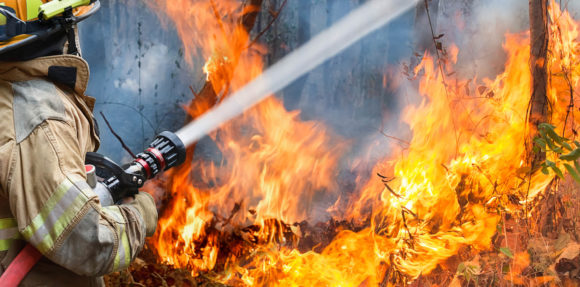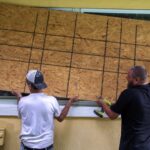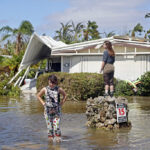While wildfire search and rescue efforts continued in Maui, a group of CoreLogic experts gathered online last week to discuss the island’s road to recovery through an insurance lens. Panelists analyzed the disaster’s uncertain billion-dollar price tag as well as potential restoration and reconstruction barriers.
“The road to recovery from an event like this will be long and arduous,” said Jon Schneyer, catastrophe response director at CoreLogic. “And the purpose of this briefing is to provide context and understanding of the degree of damage and the recovery costs to help the people of Lahaina to the best of our abilities.”
‘True Example of Urban Conflagration’
Roughly 6,500 acres of land burned across the island, and the fires were largely contained as of press time. More than 100 fatalities have been confirmed by local officials, with hundreds more still unaccounted for.
Schneyer reported that the western portion of Maui experienced moderate drought conditions prior to the fires. He explained that the area surrounding Lahaina isn’t home to dense forest or a lush, tropical landscape but instead dry grassland. Strong winds swept across the island beginning on Aug. 7.
Lahaina is predominantly densely built, single-family residential properties constructed between 1960 and 1980. These older structures — some built before air conditioning was common — relied on ventilation for cooling, which “provided ample space for embers to enter the buildings,” Schneyer said. He added that the presence of tall and dense vegetation near and between homes provided the means for fires to spread from building to building.
“Building density, vegetation, flammable materials, strong winds and little wildfire mitigation meant that the flames were able to move from building to building quite rapidly and easily,” Schneyer said. “Fires in Lahaina look to be a true example of urban conflagration in (an) area built in a wildland urban interface (and) ended up consuming over 2,000 acres.”
Ed Martinez, director of industry solutions at CoreLogic, later shared that of the nearly 70,000 residential and commercial structures located on Maui, approximately 3,000 properties rest within the perimeter of the Lahaina fire.
FEMA and the Pacific Disaster Center estimate that approximately 2,200 structures have been damaged or lost. This represents about 75% of the total building stock of Lahaina and 3% of the total number of residential and commercial structures on Maui.
Loss Total a ‘Significant Uncertainty’
As Maui remains in response mode, “we’re not really beginning in reconstruction,” said Tom Laresen, associate vice president for hazard and risk management at CoreLogic. The company’s detailed parcel database suggests total losses are likely to be between $2 billion and $4 billion.
“There is a significant uncertainty,” Larsen said. “That’s a fairly large range.”
Question marks include the speed of recovery and transition to reconstruction, the effects of inflation and the costs of materials and labor, as well as the duration of rebuilding efforts.
Re-establishing after Hurricane Iniki, the most powerful hurricane to strike Hawaii in recorded history, took about ten years. That same timeline has been given to the Camp Fire, which swept through Paradise, Calif., in 2018.
“We don’t expect this to be as ominous,” Larsen said of the Maui fire rebuilding process. “Even despite Lahaina being fairly remote in West Maui, we expect it should be able to restore much faster. And we’ll be watching that.”
Larsen said a key challenge with rebuilding can be bringing in materials, and because the main airport and shipping port were not impaired, “we don’t expect any disruption there.”
Restoration Period Barriers
That said, after surveying contractors who typically respond to events like the Maui wildfires, Brandon Burton, senior principal of industry relations for CoreLogic, found geographical limitations and mobilizing specialized professionals as unique barriers that could lengthen the restoration phase.
Individuals that have experience responding to these kinds of events have a “particular skillset,” Burton said, “that is really a specialty within a specialty.” He said they are a subset of the disaster response community that deals specifically with wildfires.
“It’s been an emerging area within the area of restoration over the course of approximately the last 20 years,” Burton said, sharing data that shows while the number of fires has remained relatively flat, the severity and extent of damage have increased.
Reconstruction: Supply-Demand Curve, Labor Costs
Jay Thies, associate vice president of data and content management at CoreLogic, highlighted complications that could arise as policyholders begin to file claims and contractors begin rebuilding.
The first building permits following the Camp Fire weren’t issued for about five months, leading CoreLogic experts to estimate that Maui rebuilding efforts won’t start for six months or more, depending on government response.
Meanwhile, the number of unpermitted structures and potential for underinsured structures “can create some valuation issues,” Thies said, “whereby the property may not be able to be reconstructed to the pre-loss condition if the amount of insurance is not sufficient. Or there’s been additional items or structures that have been added on to a property.”
He added that historically, the cost of reconstruction labor in Hawaii is about 40% higher than on the mainland. CoreLogic believes that depending on where the supply and demand curves intersect, there may be sufficient time to stock materials and not see a huge impact on material costs.
“However, on the labor side, that’s going to be a different story,” Thies said. “There’s only so much labor on the islands, and to bring labor from (the) mainland, which is going to be less preferable, it’s going to require quite a bit of cost increase.”
Related:
- Hawaiian Electric Calls Maui County’s Wildfire Lawsuit ‘Irresponsible’
- FEMA Has Paid Out $5.6M so far to Hawaii Wildfire Survivors
- Moody’s RMS Estimates $4B to $6B in Economic Losses from Hawaii Wildfires
Topics Catastrophe
Was this article valuable?
Here are more articles you may enjoy.



 Police Respond to ‘Chaos’ as Florida Condo Owners Outraged Over Insurance Fees
Police Respond to ‘Chaos’ as Florida Condo Owners Outraged Over Insurance Fees  Unusually Warm Atlantic Ocean Is Supercharging Hurricane Idalia
Unusually Warm Atlantic Ocean Is Supercharging Hurricane Idalia  Montana Brokerage Owner Admits to Defrauding Customers
Montana Brokerage Owner Admits to Defrauding Customers  Insureds Hot About Flood Insurance Costs? Some Areas Are Seeing 35% Discounts
Insureds Hot About Flood Insurance Costs? Some Areas Are Seeing 35% Discounts 

